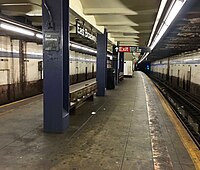East Broadway station
East Broadway | ||||||||||||||||||||||||||||||||||||||||||||||||||||||||||||||||||||||||||||||||||
|---|---|---|---|---|---|---|---|---|---|---|---|---|---|---|---|---|---|---|---|---|---|---|---|---|---|---|---|---|---|---|---|---|---|---|---|---|---|---|---|---|---|---|---|---|---|---|---|---|---|---|---|---|---|---|---|---|---|---|---|---|---|---|---|---|---|---|---|---|---|---|---|---|---|---|---|---|---|---|---|---|---|---|
 NorthboundR160F train departs | ||||||||||||||||||||||||||||||||||||||||||||||||||||||||||||||||||||||||||||||||||
| Station statistics | ||||||||||||||||||||||||||||||||||||||||||||||||||||||||||||||||||||||||||||||||||
| Address | East Broadway & Rutgers Street New York, NY | |||||||||||||||||||||||||||||||||||||||||||||||||||||||||||||||||||||||||||||||||
| Borough | Manhattan | |||||||||||||||||||||||||||||||||||||||||||||||||||||||||||||||||||||||||||||||||
| Locale | Lower East Side | |||||||||||||||||||||||||||||||||||||||||||||||||||||||||||||||||||||||||||||||||
| Coordinates | 40°42′51″N73°59′25″W/ 40.714216°N 73.990259°W | |||||||||||||||||||||||||||||||||||||||||||||||||||||||||||||||||||||||||||||||||
| Division | B(IND)[1] | |||||||||||||||||||||||||||||||||||||||||||||||||||||||||||||||||||||||||||||||||
| Line | IND Sixth Avenue Line | |||||||||||||||||||||||||||||||||||||||||||||||||||||||||||||||||||||||||||||||||
| Services | F | |||||||||||||||||||||||||||||||||||||||||||||||||||||||||||||||||||||||||||||||||
| Transit | ||||||||||||||||||||||||||||||||||||||||||||||||||||||||||||||||||||||||||||||||||
| Structure | Underground | |||||||||||||||||||||||||||||||||||||||||||||||||||||||||||||||||||||||||||||||||
| Platforms | 1island platform | |||||||||||||||||||||||||||||||||||||||||||||||||||||||||||||||||||||||||||||||||
| Tracks | 2 | |||||||||||||||||||||||||||||||||||||||||||||||||||||||||||||||||||||||||||||||||
| Other information | ||||||||||||||||||||||||||||||||||||||||||||||||||||||||||||||||||||||||||||||||||
| Opened | January 1, 1936 | |||||||||||||||||||||||||||||||||||||||||||||||||||||||||||||||||||||||||||||||||
| Accessible | notADA-accessible;accessibility planned | |||||||||||||||||||||||||||||||||||||||||||||||||||||||||||||||||||||||||||||||||
| Opposite- direction transfer | Yes | |||||||||||||||||||||||||||||||||||||||||||||||||||||||||||||||||||||||||||||||||
| Traffic | ||||||||||||||||||||||||||||||||||||||||||||||||||||||||||||||||||||||||||||||||||
| 2023 | 3,729,749[2] | |||||||||||||||||||||||||||||||||||||||||||||||||||||||||||||||||||||||||||||||||
| Rank | 83 out of 423[2] | |||||||||||||||||||||||||||||||||||||||||||||||||||||||||||||||||||||||||||||||||
| ||||||||||||||||||||||||||||||||||||||||||||||||||||||||||||||||||||||||||||||||||
| ||||||||||||||||||||||||||||||||||||||||||||||||||||||||||||||||||||||||||||||||||
| ||||||||||||||||||||||||||||||||||||||||||||||||||||||||||||||||||||||||||||||||||
| ||||||||||||||||||||||||||||||||||||||||||||||||||||||||||||||||||||||||||||||||||
| ||||||||||||||||||||||||||||||||||||||||||||||||||||||||||||||||||||||||||||||||||
TheEast Broadway stationis astationon theIND Sixth Avenue Lineof theNew York City Subway.Located atEast Broadwayand Rutgers Street in theLower East Side,it is served by theFtrain at all times and the<F>train during rush hours in the peak direction.
The East Broadway station was built for theIndependent Subway System(IND)'s Sixth Avenue Line and opened on January 1, 1936. It contains oneisland platformand two tracks. The station was initially intended as an interchange station with the Worth Street Line underneath East Broadway, to be built as part of theIND Second System,although the other line was not completed. As a result, the station contains several mezzanines, one of which was originally intended as the platform level of the Worth Street Line. The station has exits to Rutgers Street's intersections with East Broadway and withMadison Street.
History
[edit]Construction and opening
[edit]New York City mayorJohn Francis Hylan's original plans for theIndependent Subway System(IND), proposed in 1922, included building over 100 miles (160 km) of new lines and taking over nearly 100 miles (160 km) of existing lines, which would compete with the IRT and theBrooklyn–Manhattan Transit Corporation(BMT), the two major subway operators of the time.[3][4]TheIND Sixth Avenue Linewas designed to replace the elevatedIRT Sixth Avenue Line.[5]The first portion of the line to be constructed was then known as the Houston–Essex Street Line, which ran under Houston, Essex, and Rutgers Streets. The contract for the line was awarded to Corson Construction in January 1929,[6]and construction of this section officially started in May 1929.[7]
The East Broadway station opened on January 1, 1936, as the southern terminus of the first four stations to open on the Sixth Avenue Line. Two local tracks split from a junction with theEighth Avenue Linesouth ofWest Fourth Street–Washington Square,running east under Houston Street and south under Essex Street to a temporary terminal at East Broadway.[8]The station was initially served byEtrains toChurch Avenue.[9][10]Just after midnight on April 9, 1936, trains began running under the East River via the Rutgers Street Tunnel, which connected the Houston-Essex Street Line with the north end of the Culver Line at a junction with the Eighth Avenue Line north ofJay Street–Borough Hall.E trains were sent through the connection toChurch Avenue.[9][10]When further sections of the Sixth Avenue Line opened on December 15, 1940, the F train replaced the E train at the East Broadway station.[11]
Station renovation
[edit]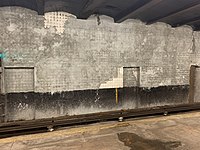
In June 2018, improvements to the East Broadway station's exits were proposed as part of the development of the controversial247 Cherry,269 South Street,and259 Clinton Streetskyscrapers. The developers planned to create an entrance at the northeastern corner of Rutgers and Madison Streets by reusing part of the existing closed exit and creating a new street stair parallel to Madison Street from the passage.[12]In addition to a new exit, the developers planned to make the station compliant with theAmericans with Disabilities Act of 1990with the installation of elevators.[13]The plan was approved that December,[14]but the developments were blocked by aNew York Supreme Courtjudge in February 2020, making the proposed improvements unlikely to occur.[15]
The Rutgers Street Tunnel was refurbished starting in late 2020.[16][17]As part of the work, the East Broadway station's structural system was repaired and painted, while the platform edges, wall tiles, and stairs were replaced. Work was completed in February 2021.[18]
Station layout
[edit]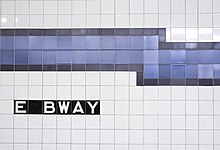
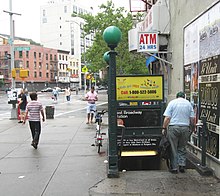
| G | Street level | Exits/entrances |
| B1 | Mezzanine | Fare control, station agent |
| B2 | Mezzanine | Connection between fare control and platforms |
| B3 | Mezzanine[19] | Closed, used for maintenance |
| B4 Platform level |
Northbound | ← |
| Island platform | ||
| Southbound | ||
The station has one narrow, slightly curvedisland platform.There is an abandoned tower at the north end of the platform.
The tile band is medium Parma violet with a slightly darker border, set two tiles high. Tile captions below show the station name abbreviated as "E BWAY" in white letters on black. The I-beam columns are painted a similar shade of dark violet. The trackside walls showed a considerable pattern of aging and occasional water damage prior to the station's renovation, which replaced all the tiles and remained mostly faithful to the original design.
The 1992 artwork at this station is calledDisplacing Detailsby Noel Copeland, with assistance by students from theHenry Street Settlement.
There are many closed sections at East Broadway, including restrooms that have been converted to office spaces. Inside fare control, the open intermediate level's mezzanine is split into two halves; the portion between the two halves was shuttered and is now used as maintenance space. Right below the open intermediate level is an entire closed intermediate level mezzanine, which is indicated by a brief intermediate level on staircases from the open mezzanine to the platform and now serves as storage space as well.[20]This closed mezzanine is accessible through fenced-off stairways at the either end of the station.
Unfinished station
[edit]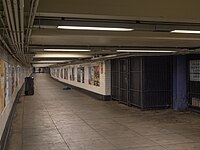
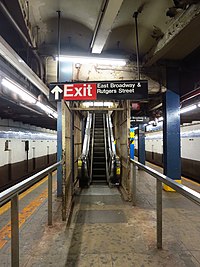
The north half of the open intermediate level mezzanine was designed to eventually become a station of the unbuiltIND Worth Street Line.A locked door, located in the north end of the mezzanine, reveals additional closed platform space and an electrical room that hides the rest of the trackway and platform space. In this closed space, the platform floor drops to the level of the intended westbound trackway for the unbuilt line.[21]
The unused space runs for no more than 15 feet (4.6 m) before ending at a solid wall. Another door that leads to the electrical room hides the eastbound trackway. Near the north end of this station, a different ceiling structure angling across marks where the unbuilt subway would have gone.[22]The ramp that descends from the full-time side would have led to the same intermediate level, with a station facility in between, but that was never constructed. On the open intermediate level's mezzanine, the unusual spacing of some of the pillars marks where the line's platforms would have been placed.[23][24]
Exits
[edit]The station has twomezzanines,four open staircases, three closed staircases, and one escalator. The full-time entrance at Madison Street has one street staircase, while the part-time entrance atCanaland Rutgers Streets has three. A passageway outside offare controlconnects the two areas.
All exits to the station are street stairs. There is an exit to the northeastern corner of Canal Street and Essex Street, the western side of Rutgers Street between Canal Street and East Broadway, to the southeastern corner of East Broadway and Rutgers Street, and to the northwestern corner of Madison Street and Rutgers Street.[25]
In addition to the open entrances, there are two closed exits to the southwestern and northeastern corners of Henry Street and Rutgers Street that lead to the middle of the passageway outside fare control. There was also a short passage with a street stair parallel to Rutgers Street to the northeastern corner of Madison Street and Rutgers Street.
References
[edit]- ^"Glossary".Second Avenue Subway Supplemental Draft Environmental Impact Statement (SDEIS)(PDF).Vol. 1. Metropolitan Transportation Authority. March 4, 2003. pp. 1–2. Archived fromthe original(PDF)on February 26, 2021.RetrievedJanuary 1,2021.
- ^ab"Annual Subway Ridership (2018–2023)".Metropolitan Transportation Authority.2023.RetrievedApril 20,2024.
- ^"Two Subway Routes Adopted by City".The New York Times.August 4, 1923. p. 9.ISSN0362-4331.Archivedfrom the original on June 30, 2019.RetrievedAugust 1,2019.
- ^"Plans Now Ready to Start Subways".The New York Times.March 12, 1924. p. 1.ISSN0362-4331.Archivedfrom the original on June 28, 2019.RetrievedAugust 1,2019.
- ^"Delaney For Razing Elevated Line Now; Work in 6th Av. Could Begin in Six Months if Condemnation Started at Once, He Says. Sees Cut In Subway Cost Eliminating Need for Underpinning Would Save $4,000,000 and Speed Construction, He Holds".The New York Times.January 11, 1930.ISSN0362-4331.Archivedfrom the original on April 28, 2018.RetrievedApril 27,2018.
- ^"East Side Subway Will Evict 10,000; Work on New Line, Likely to Begin in May, Will Force Many Tenants to Move. 200 Buildings Will Fall Transportation Board Notifies Property Owners—Condemnation to Coat Over $11,000,000. Expect Work to Start in May. Residents Recall Other Days".The New York Times.February 24, 1929.ISSN0362-4331.Archivedfrom the original on May 6, 2022.RetrievedApril 28,2018.
- ^"East Side Subway Started By Mayor; He Breaks Ground for Crosstown System at Second Av. and East Houston St. Miller Hails Project Sees Area Rejuvenated by Line and City's Plan to Raze Old Tenements".The New York Times.May 2, 1929.ISSN0362-4331.Archivedfrom the original on April 28, 2018.RetrievedApril 28,2018.
- ^"LaGuardia Opens New Subway Link".The New York Times.January 2, 1936. p. 1.ISSN0362-4331.Archivedfrom the original on December 11, 2021.RetrievedOctober 7,2011.
- ^ab"Two Subway Links Start Wednesday".The New York Times.April 6, 1936. p. 23.ISSN0362-4331.Archivedfrom the original on June 14, 2018.RetrievedOctober 7,2011.
- ^ab"New Subway Link Opened by Mayor".The New York Times.April 9, 1936. p. 23.ISSN0362-4331.Archivedfrom the original on December 11, 2021.RetrievedOctober 7,2011.
- ^"The New Subway Routes".The New York Times.December 15, 1940.ISSN0362-4331.Archivedfrom the original on April 16, 2018.RetrievedApril 15,2018.
- ^https://www1.nyc.gov/assets/planning/download/pdf/applicants/env-review/two-bridges/noc-feis.pdfArchivedAugust 9, 2019, at theWayback Machinepage 45
- ^Warerkar, Tanay (June 25, 2018)."Two Bridges skyscrapers to begin public review as locals, pols call for more time".Curbed NY.Archivedfrom the original on December 19, 2018.RetrievedDecember 18,2018.
- ^"City Planning approves controversial trio of resi towers in Two Bridges".The Real Deal New York.December 5, 2018.Archivedfrom the original on January 10, 2021.RetrievedDecember 18,2018.
- ^"A Second Ruling Against City's Approval of Two Bridges Skyscrapers".City Limits.February 25, 2020.Archivedfrom the original on April 7, 2020.RetrievedMay 24,2020.
- ^Hallum, Mark (December 8, 2020)."Rutgers Tube rehab on F line to enter final phase of completion Jan. 1: MTA".amNewYork.Archivedfrom the original on May 13, 2022.RetrievedMarch 22,2021.
- ^McGoldrick, Meaghan (July 21, 2020)."Repairs to Hurricane Sandy-Damaged F Train Tunnel Will Start in August".Brownstoner.Archivedfrom the original on August 20, 2020.RetrievedMarch 22,2021.
- ^"Capital Program Oversight Committee Meeting".Metropolitan Transportation Authority. March 17, 2021.Archivedfrom the original on April 21, 2021.RetrievedMarch 22,2021.
- ^"East Broadway Mezzanine".LTV Squad.December 31, 2006.
- ^"East Broadway Mezzanine".LTV Squad.December 31, 2006.Archivedfrom the original on July 26, 2018.RetrievedSeptember 15,2016.
- ^"Essex Street - East Broadway - the IND Second System".Archived fromthe originalon March 4, 2016.RetrievedSeptember 23,2015.
- ^https://web.archive.org/web/20100625185833/http://www.columbia.edu/~brennan/abandoned/EBway.ceil.jpg.Archived fromthe original(JPG)on June 25, 2010.
{{cite web}}:Missing or empty|title=(help) - ^http://www.columbia.edu/~brennan/abandoned/EBway.mezz2.jpg.Archivedfrom the original on April 24, 2013.RetrievedFebruary 9,2014.
{{cite web}}:Missing or empty|title=(help) - ^http://www.columbia.edu/~brennan/abandoned/EBway.mezz1.jpg.RetrievedFebruary 9,2014.
{{cite web}}:Missing or empty|title=(help) - ^"MTA Neighborhood Maps: Lower East Side"(PDF).Metropolitan Transportation Authority.2015.Archived(PDF)from the original on July 24, 2015.RetrievedAugust 6,2015.
External links
[edit]- nycsubway.org –IND 6th Avenue: East Broadway
- Station Reporter —F Train
- Abandoned Stations —IND Second System unfinished stations
- East Broadway entrance from Google Maps Street View
- Canal Street entrance from Google Maps Street View
- Madison Street entrance from Google Maps Street View
- Mezzanine from Google Maps Street View
- Platform from Google Maps Street View





